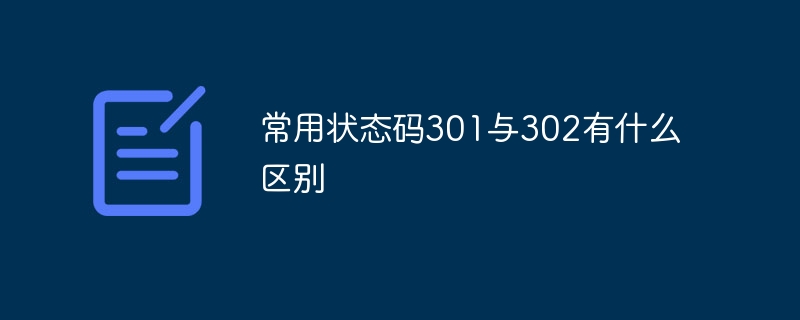What is the difference between common status codes 301 and 302?
Commonly used status codes 301 and 302 are both HTTP redirection status codes. The difference between them is: 1. 301 indicates that the requested resource has been permanently moved to a new location, while 302 indicates that the requested resource has been permanently moved to a new location. The requested resource is temporarily moved to a new location; 2. When 301 redirects, the search engine will transfer the search ranking of the original URL to the new URL, while when 302 redirects, the search engine will not transfer the search ranking of the original URL. The ranking is passed to the new URL.

# Operating system for this tutorial: Windows 10 system, Dell G3 computer.
Commonly used status codes 301 and 302 are HTTP redirect status codes, which indicate that the resource requested by the browser or client has been permanently (301) or temporarily (302) transferred to another location.
The differences are as follows:
301 Moved Permanently: Indicates that the requested resource has been permanently moved to a new location. Search engines will pass the search rankings of the original URL to the new URL. When you apply a 301 redirect, the browser or client caches the redirect and sends future requests directly to the new location.
302 Found (temporary redirection): Indicates that the requested resource has been temporarily moved to a new location. Search engines do not transfer the search rankings of the original URL to the new URL. When applying a 302 redirect, the browser or client sends the request to the original location every time instead of caching the redirect.
In summary, the 301 status code is used for permanent redirects, usually when the website structure changes or the old URL is migrated to a new URL. The 302 status code is used for temporary redirection, usually for temporary maintenance, access restrictions, or jumping to other functional pages.
The above is the detailed content of What is the difference between common status codes 301 and 302?. For more information, please follow other related articles on the PHP Chinese website!

Hot AI Tools

Undresser.AI Undress
AI-powered app for creating realistic nude photos

AI Clothes Remover
Online AI tool for removing clothes from photos.

Undress AI Tool
Undress images for free

Clothoff.io
AI clothes remover

AI Hentai Generator
Generate AI Hentai for free.

Hot Article

Hot Tools

Notepad++7.3.1
Easy-to-use and free code editor

SublimeText3 Chinese version
Chinese version, very easy to use

Zend Studio 13.0.1
Powerful PHP integrated development environment

Dreamweaver CS6
Visual web development tools

SublimeText3 Mac version
God-level code editing software (SublimeText3)

Hot Topics
 deepseek web version official entrance
Mar 12, 2025 pm 01:42 PM
deepseek web version official entrance
Mar 12, 2025 pm 01:42 PM
The domestic AI dark horse DeepSeek has risen strongly, shocking the global AI industry! This Chinese artificial intelligence company, which has only been established for a year and a half, has won wide praise from global users for its free and open source mockups, DeepSeek-V3 and DeepSeek-R1. DeepSeek-R1 is now fully launched, with performance comparable to the official version of OpenAIo1! You can experience its powerful functions on the web page, APP and API interface. Download method: Supports iOS and Android systems, users can download it through the app store; the web version has also been officially opened! DeepSeek web version official entrance: ht
 In-depth search deepseek official website entrance
Mar 12, 2025 pm 01:33 PM
In-depth search deepseek official website entrance
Mar 12, 2025 pm 01:33 PM
At the beginning of 2025, domestic AI "deepseek" made a stunning debut! This free and open source AI model has a performance comparable to the official version of OpenAI's o1, and has been fully launched on the web side, APP and API, supporting multi-terminal use of iOS, Android and web versions. In-depth search of deepseek official website and usage guide: official website address: https://www.deepseek.com/Using steps for web version: Click the link above to enter deepseek official website. Click the "Start Conversation" button on the homepage. For the first use, you need to log in with your mobile phone verification code. After logging in, you can enter the dialogue interface. deepseek is powerful, can write code, read file, and create code
 How to solve the problem of busy servers for deepseek
Mar 12, 2025 pm 01:39 PM
How to solve the problem of busy servers for deepseek
Mar 12, 2025 pm 01:39 PM
DeepSeek: How to deal with the popular AI that is congested with servers? As a hot AI in 2025, DeepSeek is free and open source and has a performance comparable to the official version of OpenAIo1, which shows its popularity. However, high concurrency also brings the problem of server busyness. This article will analyze the reasons and provide coping strategies. DeepSeek web version entrance: https://www.deepseek.com/DeepSeek server busy reason: High concurrent access: DeepSeek's free and powerful features attract a large number of users to use at the same time, resulting in excessive server load. Cyber Attack: It is reported that DeepSeek has an impact on the US financial industry.





